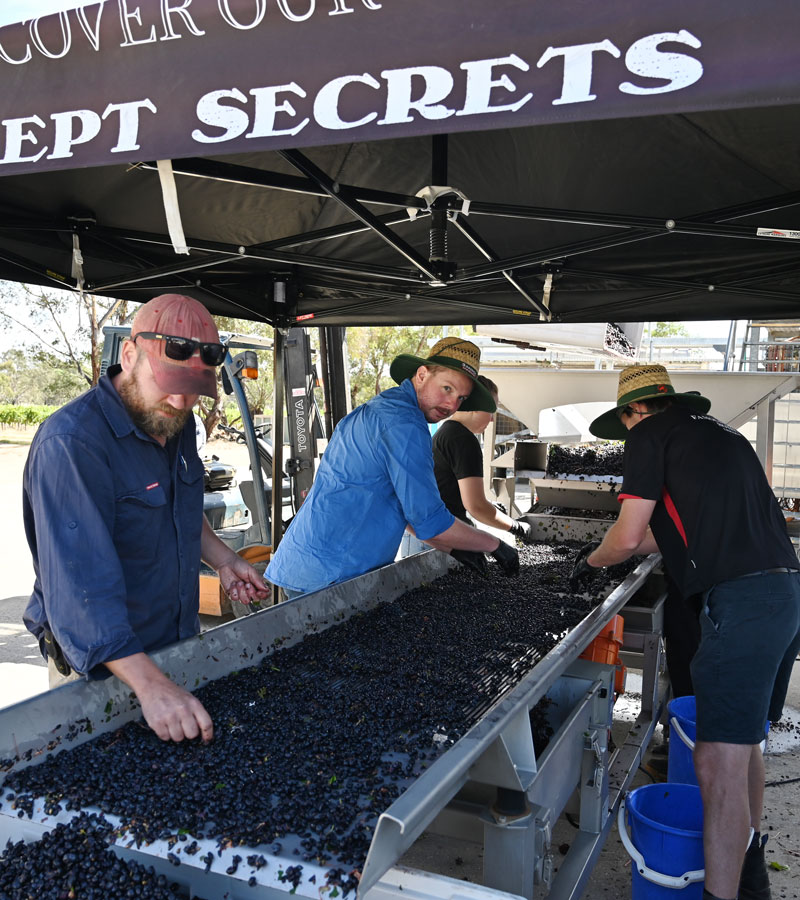The World’s Oldest Pinot Noir Vines?
We’re putting the question out there, does Best’s Wines in Great Western have the world’s oldest Pinot Noir vines? With our vineyard planted in 1868 there’s certainly some pedigree at play. No one has ever refuted us when we make the claim that our historic Victorian vineyards could be home to the oldest living Pinot Noir, Pinot Meunier and Dolcetto vines. Let us tell you the significance of our tiny parcels of Pinot Noir and showcase the wines that we make from some of these special vines.

The Early Days of Pinot Noir
Pinot Noir vines have been planted since the first century. The ancient Romans began drinking it, due to its popularity in the recently conquered Gaul regions, in what later became France. As Vinepair pointed out:
“Around the year 1,000 A.D., long after the Romans had abandoned their early vineyards in France. The Cistercian order of Monks began gaining authority outside the modern city of Dijon. In addition to vows of poverty and abstinence. These monks believed a devotion to hard labor brought them closer to god. They began cultivating the rocky hillsides of early Burgundy. Over hundreds of vintages, they painstakingly maintained detailed records of their vineyards. The monks describing exactly how, and exactly where vines thrived or withered — and how the resulting wines tasted.”
It’s the red grape varietal now synonymous with the Burgundy region in France and ever since has been known as a wine of both quality and scarcity.
Pinot Noir Plantings in Australia
The history of Pinot Noir in Australia dates back to early settlement having been planted since the early 1800s. Wine Australia noted that it was one of the varieties brought into Australia by John McArthur in 1817 and by James Busby in the 1830s.
At Best’s, Pinot Noir vines were part of Henry Best’s original collection. However, Pinot Noir is not as easily identified as some of the other reds. In the late 1960s that we started to learn more about the different profiles of grapes in our famous vineyards. We unearthed the significance of our Pinot Noir resources which were hidden amongst our Pinot Meunier vines. More on that later…
Whilst we don’t have the long vine history of many European nations. It was the original plantings here in Australia that have become a significant historical reference point. Viticulturalists and ampleographers would come from all over the world to learn more from our vines, given the tragedy that struck across Europe.
Phylloxera Wipes Out France’s Historic Vineyards
In the late 19th century, the grape phylloxera epidemic destroyed most of the vineyards for wine grapes in Europe. France was particularly impacted. These tiny, microscopic insects, related to aphids, feed on the roots and leaves of the grapevines. The result is deformations and secondary fungal infections. Which cut off the flow of nutrients and water to the vine until it dies. In 1863, the first vines began to deteriorate inexplicably in the southern Rhône region of France. The problem spread rapidly across the continent. In France alone, total wine production fell from 84.5 million hectolitres in 1875 to only 23.4 million hectolitres in 1889. Some estimates hold that between two-thirds and nine-tenths of all European vineyards were destroyed.
Much of the Pinot Noir planted in France was destroyed by the phylloxera bug. We have not been able to ascertain if any of the older Pinot plantings survived. Some vineyards in Champagne may have lived but we’re unsure whether these were Chardonnay, Pinot Noir or Pinot Meunier. This poses the question about whether our vines are now the oldest?
Managing Phylloxera
Currently there is no cure for phylloxera. Although technological advancements have allowed us to learn more about how to minimise damage. Luckily some of those original grape materials had already been sent to Australia in the early 1800s. Before the disease became widespread in Europe. Australia was not impacted by phylloxera like the Europeans. Although some regions have been exposed and vineyards lost. Fortunately, we’ve been incredibly lucky here in Great Western. Strict viticultural practices in place answers why we have some of the world’s oldest living vines today.
Disease can spread quickly – and the pests can travel unintentionally through equipment, clothing or footwear! It’s the cautionary tale that leads many wineries (including Best’s) to adopt strict vineyard protocols. We want to ensure that we’re not brining unwanted diseases into our vineyards and protecting the health of our vines.
Best’s Wines Pinot Noir Vineyards
Henry Best first planted his vineyards along the Concongella Creek in 1868. Pinot Noir was one of the grapes which were planted. Back in the day a lot of the older vineyards were planted as a field blend. Many varietals of smaller importance like Mixed Trouette (identified in Henry Best’s diary). Or local name varieties were dispersed throughout the field blend plantings. Another theory of Ben Thomson’s is that perhaps there were some strings that had come undone from the bundles of vines. Cuttings were scattered. When they bundled them up again prior to planting, some of the red and white grape cuttings may have got mixed up. So when they were planted it was like a jigsaw puzzle trying to piece them back together. It certainly would explain the chaos that lays claim to some of the plantings in our Nursery Block.
Some of these older plantings contained vines that we have long referred to as Miller’s Burgundy. The particular vineyard has a distinctive leaf – one that’s furry and somewhat resembles a Lambs Ear plant. The leaf looks like it was dusted with flour and hence the name. Miller meaning ‘Meunier’ in France. Alongside this rough leafed vine was one that was smooth, with these small amounts of vines dispersed throughout the vineyard. Nowadays, the odd old vine is a rare anomaly, where the vine literally splits in two where half the plant has one smooth leaf, and the rest the other which is furry. Ben Thomson notes “It clearly just wants to be known as Pinot!”
Pinot Noir and Pinot Meunier
Viv Thomson was not aware that the vines in the old Meunier block were Pinot Noir, only that there was something slightly different which was intertwined. He took cuttings in the winter of 1970 and sent them to the nursery. The nursery confirmed that these were indeed two varietals. During winter it’s hard to identify differences. The nursery staff questioned if they were to separate them and obviously, he was keen to know more. They came back as Pinot Noir and Pinot Meunier rootlings and were planted at the back of the vineyard.
Subsequent Pinot Noir was also planted at the back of the winery in the House Block in the early 80s, with a range of clones that Viv Thomson was experimenting with through work with the CSIRO.
In the mid-1980s, Danny Schuster, a viticulturalist and author of several viticulture books identified that the vineyard was largely Pinot Meunier (the rough leaf), but also featured Pinot Noir (the smooth leaf). In the vineyard there were two clones of Pinot Noir – one Swiss and one French. The French clone was deemed superior so a further 11 rows of the French selection were planted in 1987.
In 1997 we planted Pinot Noir in our Salvation Hills Vineyard at Rhymney, which is about 10km from our Great Western winery home and slightly more elevated. This vineyard has been in the Thomson family since 1996.
Have a look at some of the old vines yourself where winemaker Justin Purser explains the historical significance.
The Best’s Pinot Noir Style
The lighter, approachable type of wine made from Pinot Noir has always been a style that we’ve championed at Best’s. The 1967 Miller’s Burgundy was Viv Thomson’s first vintage. We know Viv and his father Eric didn’t blend this wine. Miller’s Burgundy was made from the old Meunier blocks, which we now know had a component of Pinot Noir in it.
In the early 80s the focus was on Pinot Meunier and then Pinot Noir when it was planted. Our Best’s Shiraz was also different to other parts of Australia, a lighter more medium-bodied style. Hamish Thomson recalls being out in the trade with his dad Viv Thomson in the early 80’s and Viv was proudly promoting Pinot Meunier. At the time Best’s was one of the few Australian wine producers who was pioneering lighter reds. Rather than producing them as a bigger style of red which was being made in other parts of Australia. It was distinctive, but many were still afraid of red wines that you could ‘see through’ Viv used to say.
Our first straight Pinot Noir arrived in 1991. Pinot Noir is now made from a combination of the 1980 and ’87 vineyards. There’s been several different Pinot Noir wines that we’ve released over the years. Our Old Clone Pinot Noir is obviously highly sought after, coming off cuttings from the old vineyards. These vines planted in on their own roots along with the rest of the block which were planted on rootstocks. The PSV 141 (Pig Sty Vineyard) Pinot Noir which we released for our 150th celebrations in 2016. The PSV 141, picked from the original 141 vines is a special wine of place and significance.
Great Western Pinot Noir
For many wine lovers, it’s our Great Western Pinot Noir that they discover first. The Great Western Pinot Noir been well noted over recent years for the exceptional value. One of the highly rated wines in the collection which saw us named 2021 Halliday Wine Companion Best Value Winery in Australia.
Pinot Noir from Great Western is truly distinctive, characterised by the climate, soil and weather patterns. Many other Victorian producers from regions like the Yarra Valley and Mornington Peninsula have not expanded to the West. Staying within their defined appellations as they fear it’s too hot to successfully grow Pinot Noir.
Ben Thomson notes that “we’ve been growing Pinot Noir longer than 90% of the other Pinot Noir producers here in Victoria. We’re still drinking old Pinots with over 40 years of age, and they are tasting phenomenal. Where else in Australia can you get wines like that?”





